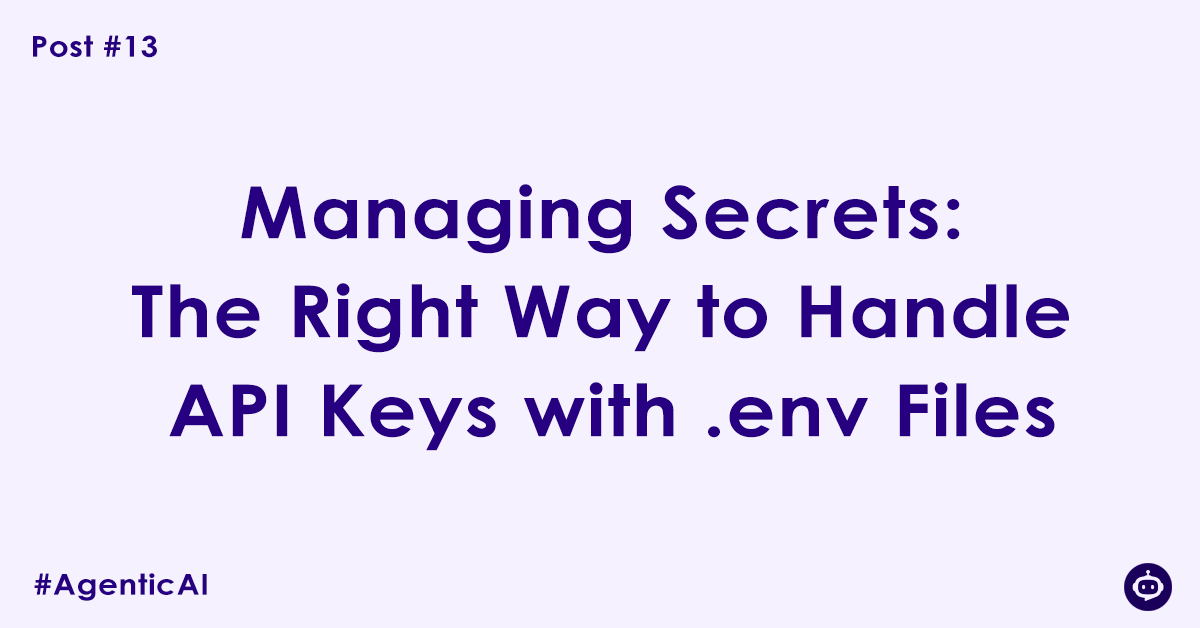So far, we’ve built a professional workshop for our AI projects. We have our clean environment, our version control, and our powerful code editor. Before we can connect to a Large Language Model and start building, we must address the most critical topic in modern development: security.
Hardcoding an API key directly into your script is like writing your house key number on your front door and then posting a picture of your door on the internet. It’s a massive, avoidable security risk that can have catastrophic consequences.
This guide will teach you the professional standard for managing “secrets”—like API keys, database passwords, and other sensitive credentials—using a simple, robust method: .env files.
The “Why”: The Extreme Dangers of Hardcoded Keys
“Hardcoding” means writing a secret directly in your code, like this:
# DO NOT DO THIS! THIS IS DANGEROUS!
api_key = "sk-aBcDeFgHiJkLmNoPqRsTuVwXyZ1234567890..."Here’s why this is a terrible idea:
- Accidental Public Exposure: The moment you use Git to “commit” this file, your secret key is saved into your project’s history. If you then push this project to a public repository on GitHub, bots that are constantly scanning for this exact format will find your key in seconds. Before you even realize it, malicious actors could be using your key, racking up thousands of dollars in charges on your account.
- Difficult to Change (or “Rotate”): If your key is ever compromised, you’ll need to change it. If it’s hardcoded in ten different files, you have to hunt them all down. Managing secrets properly means you only have to change them in one place.
- Inflexible for Collaboration: Your teammate will have a different API key. When you share code, you’ll have to constantly edit the keys, creating confusion and increasing the risk of accidentally committing someone else’s secret.
The solution is to store secrets in your local environment, completely separate from your version-controlled code.
The “How”: A Step-by-Step Guide to Using .env Files
This method uses a simple text file (.env) to store your secrets and a small Python library to load them into your application.
Step 1: Install python-dotenv
Make sure your virtual environment (venv) is activated, then install the necessary library.
pip install python-dotenvAs always, keep your project’s dependency list up to date. This is a crucial best practice.
pip freeze > requirements.txtStep 2: Create Your .env File
In the root directory of your project, create a new file named exactly .env.
Inside this file, you’ll store your secrets as key-value pairs.
# .env file
# This is a comment. Store your secrets here.
# Use ALL_CAPS for variable names by convention.
OPENAI_API_KEY="sk-YourSecretKeyGoesHere"
GOOGLE_API_KEY="aIzaSyYourSecretKeyGoesHere"Important: There should be no spaces around the = sign.
Step 3: Add .env to .gitignore (THE CRITICAL STEP)
This is the step that keeps you safe. You must tell Git to explicitly ignore your .env file so it is never, ever tracked or uploaded to GitHub.
Open the .gitignore file you created in Post #11 and add a new line for .env:
# .gitignore
# Virtual Environment
venv/
# Python cache
__pycache__/
# Environment variables - DO NOT TRACK!
.envWith this line in place, your secrets will remain safely on your local machine.
Step 4: Load and Use Secrets in Your Python Code
Now, let’s see how to access these secrets in your script. Create a file like main.py:
# main.py
import os
from dotenv import load_dotenv
# Load environment variables from the .env file
load_dotenv()
# Now you can access the variables using os.getenv()
my_openai_key = os.getenv("OPENAI_API_KEY")
if my_openai_key:
print("OpenAI API Key loaded successfully!")
# For security, never print the full key. Just show a part of it.
print(f"Key starts with: {my_openai_key[:6]}...")
else:
print("API Key not found. Please check your .env file.")
# In a real agent, you would use this variable to initialize a client:
# from openai import OpenAI
# client = OpenAI(api_key=my_openai_key)When you run python main.py, the load_dotenv() function finds the .env file, and os.getenv() securely reads the value without you ever having to write it in your code.
The Collaborative Workflow: Using .env.example
When a teammate clones your repository, they won’t get your .env file (because it’s in .gitignore). So how do they know what secrets they need to provide?
The professional solution is to include a template file called .env.example that is committed to Git.
Create a file named .env.example:
# .env.example
# Copy this file to .env and fill in your personal API keys.
OPENAI_API_KEY=""
GOOGLE_API_KEY=""This file acts as documentation, showing other developers exactly what variables are required to run the project.
Conclusion
Properly managing your secrets isn’t an “advanced” topic—it is a fundamental, day-one skill for every developer. By following this simple workflow, you protect yourself, your team, and your project from potentially devastating security breaches.
The golden rule is simple: Secrets do not belong in your code. Never commit secrets to Git.
Author

Experienced Cloud & DevOps Engineer with hands-on experience in AWS, GCP, Terraform, Ansible, ELK, Docker, Git, GitLab, Python, PowerShell, Shell, and theoretical knowledge on Azure, Kubernetes & Jenkins. In my free time, I write blogs on ckdbtech.com
